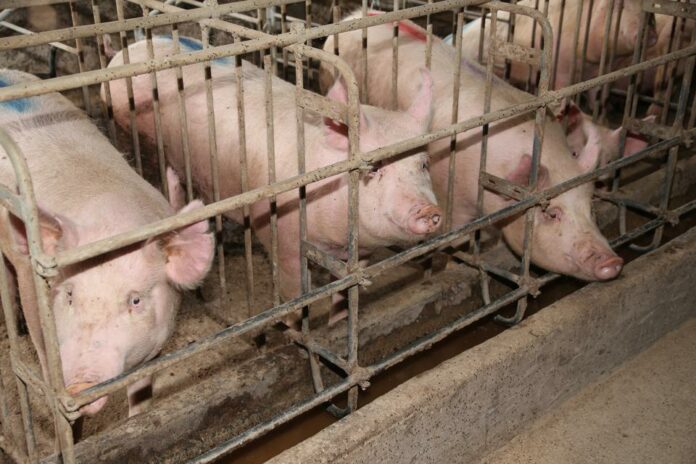Gestation crates for pigs – The pork-based meat industry is one of the most extensive and profitable industries globally. Millions of pigs are slaughtered yearly to provide meat for human consumption. However, behind the shiny facade of this industry lies a dark and sad reality. The industry’s relentless pursuit of profits has led to the inhumane treatment of pigs, particularly female pigs treated as breeding machines.
In the pork-based meat industry, female pigs are used for breeding purposes to produce piglets, which are then raised for slaughter. These breeding pigs are confined to cramped and often dirty conditions, where they are impregnated and forced to give birth repeatedly until they are no longer productive.
The industry prioritizes the reproductive capacity of female pigs over their welfare, leading to various health complications, including infections, lameness, and reproductive problems.
The saddest part of the breeding process is the separation of piglets from their mothers. Female pigs are usually kept in farrowing or Gestation crates for pigs, which are so small that the pigs cannot even turn around.
The piglets are taken away from their mothers within days of birth, causing immense distress and suffering to both the mother and the offspring. The piglets are reared in cramped and often dirty conditions, leading to health problems and a shortened lifespan.
Furthermore, the pork-based meat industry is notorious for its cruel practices. The industry frequently uses practices like tail docking and teeth clipping without pain relief. These practices prevent tail biting and other aggressive behavior resulting from the stressful and unnatural conditions in which these animals are kept.
The plight of female pigs in the pork-based meat industry is heartbreaking. These sentient creatures are treated as machines, with their lives revolving around breeding and giving birth. They can never experience a natural life with fresh air, open spaces, and social interaction. Their lives are a never-ending cycle of confinement, insemination, and giving birth, only to see their babies taken away.
Read More- List Of The Cute And Beautiful Bird With Red Head
What is Gestation Crates for Pigs?
Gestation crates for pigs are among the pork-based meat industry’s most controversial and cruel practices. These crates are small, restrictive cages that confine female pigs during pregnancy. The sole purpose of these crates is to restrict the movement of the pregnant pigs to ensure maximum control and efficiency over the breeding process, with no consideration for the welfare of the animals.
The sad reality of these gestation crates is that they deny pregnant pigs the opportunity to move freely, socialize, and express their natural behavior. The pigs are forced to spend their entire pregnancy in these tiny cages, unable to turn around or take a few steps.
They often cannot lie comfortably, leading to physical and psychological distress. The cramped conditions and lack of exercise lead to muscle atrophy and other physical problems, causing immense pain and discomfort for these animals.
The use of gestation crates is a practice that prioritizes profit over animal welfare. These crates are designed to maximize the number of pigs that can be raised in a small space while reducing the cost of labor. The industry’s sole focus is on efficiency and productivity, with no regard for the suffering and misery of the animals in their care.
Seeing pregnant pigs confined to these tiny gestation crates is a sad and heart-wrenching reality that should evoke empathy and compassion in any observer. The animals are trapped in these crates, unable to express their natural behavior or move freely. The conditions are often unsanitary and unclean, with the animals forced to lie in their waste.
What is the Difference between Farrowing Crates and Gestation Crates for Pigs?
The pork-based meat industry is known for its inhumane practices prioritizing profit over animal welfare. Two of the most commonly used practices are gestation and farrowing crates used to confine and control pregnant pigs.
Gestation crates are small, restrictive cages that confine pregnant pigs between insemination and farrowing. These crates are designed to restrict the movement of the pigs and maximize control over the breeding process. The pigs cannot move freely or express their natural behavior, leading to immense physical and psychological suffering. They are trapped in these crates, unable to turn around or take a few steps, causing immense pain and discomfort.
Farrowing crates are used to confine sows while giving birth and nursing piglets. These crates are larger than gestation crates, allowing the sows to lie down and nurse their young. However, these crates still do not meet the sows’ basic needs, and are still forced to live in cramped conditions with little room to move. The piglets are taken away from the sows within days of birth, causing immense distress and suffering to both the mother and the offspring.
Farrowing and gestation crates are cruel practices that deny pregnant pigs their basic needs and cause immense suffering. The pigs are viewed as nothing more than commodities, with their lives revolving around breeding and giving birth.
They are confined to small spaces, unable to move or express their natural behavior, leading to immense physical and psychological distress.
Using farrowing and gestation crates is a sad reality that should evoke empathy and compassion in any observer. These practices must be recognized for what they are: cruel.
We are responsible for speaking out against these practices and demanding better treatment for these sentient beings. The pork-based meat industry must prioritize animal welfare over profit and end these barbaric practices.
Read More- LIST OF ANIMALS THAT LOOK LIKE SQUIRRELS
How many pigs are kept in a Gestation Crate for Pigs?
These crates are designed to maximize efficiency and productivity, with little consideration for the welfare of the animals. Typically, one pig is kept in a gestation crate at a time, with barely enough space to move or turn around.
This lack of space and confinement can cause immense physical and psychological suffering for the pigs, leading to a debate on the ethics of such practices.
Why do breeders use Gestation Crates for pigs?
Farmers use gestation crates in the pork-based meat industry to maximize efficiency and productivity. These crates are designed to restrict the movement of pregnant pigs, allowing for tighter control over the breeding process.
The pigs are confined to small, restrictive cages with barely enough space to move or turn around. This confinement is believed to reduce aggression between the pigs and increase the chances of a successful pregnancy.
However, the use of gestation crates is widely criticized for its inhumane practices. The pigs are denied their basic needs and are forced to live in cramped conditions, causing immense physical and psychological distress.
The lack of space and movement can lead to muscle and bone weakness and the development of sores and infections. Furthermore, the social isolation that comes with confinement can lead to immense psychological suffering, with the pigs experiencing anxiety, stress, and depression.
Despite the widespread criticism, farmers continue to use gestation crates in the pork-based meat industry, driven by the need to maximize efficiency and profit.
The welfare of the pigs is often overlooked in favor of increased productivity, leading to immense suffering and cruelty. It is important to recognize the sad reality of using gestation crates and demand better treatment for these sentient beings.

Why are Gestation Crates for Pig bad?
Pigs are highly social and intelligent animals who naturally desire to move around and interact with others. However, when kept in gestation crates, they are denied the freedom of movement, causing immense pain and discomfort. The pigs are forced to live in cramped conditions with barely enough space to turn around, causing muscle and bone weakness and developing sores and infections.
The social isolation that comes with confinement can lead to immense psychological suffering, with the pigs experiencing anxiety, stress, and depression. They cannot express their natural behavior, such as rooting and nest building, causing frustration and boredom.
The use of gestation crates is not only cruel to the pigs, but it also has negative impacts on their offspring. Pigs raised in gestation crates often have weakened immune systems and physical deformities, causing a higher risk of illness and disease.
Despite widespread criticism of this practice, many farmers continue to use gestation crates in the pork-based meat industry. The need to maximize efficiency and profit often takes priority over animal welfare, leading to immense suffering and cruelty.
Several countries, including the UK and Sweden, have banned using gestation crates, recognizing them as a cruel practice. However, many other countries, including the US, still allow their use.
We are responsible for recognizing the sad reality of using gestation crates and demanding better treatment for these sentient beings. The pork-based meat industry must prioritize animal welfare over profit and end these barbaric practices.
As consumers, we can make a difference by purchasing meat from farms that prioritize animal welfare and do not use gestation crates.
We must raise our voices and demand change, calling for the end of these cruel practices that cause animals immense physical and psychological suffering.
It is time to end using gestation crates and work towards a more compassionate and ethical future for all animals.
Read More- What is Adaptation in Animals?
Wrapping Up
In conclusion, using gestation crates is a cruel practice that causes immense physical and psychological suffering to pigs. The confinement and lack of movement lead to muscle and bone weakness, sores and infections, and psychological distress.
The negative impacts of this practice extend beyond the individual pigs and affect their offspring, leading to weakened immune systems and physical deformities. We are responsible for recognizing the suffering caused by gestation crates and demanding better treatment for these sentient beings.
We must choose to support farms that prioritize animal welfare and do not use gestation crates and raise our voices to call for change in the pork-based meat industry. It is time to end using gestation crates and work towards a more compassionate and ethical future for all animals.
Read More- 8 Intresting Facts About Duck Billed Platypus
Frequently Asked Questions (FAQs):
What is the purpose of gestation crates?
Gestation crates, also known as sow stalls, confine pregnant pigs between insemination and farrowing, allowing for tighter control over breeding.
What is the size of gestation crates?
The typical size of a gestation crate is around 7 feet long and 2 feet wide, with barely enough space for the pig to turn around.
Are gestation crates legal?
The legality of gestation crates varies by country and state. Some countries and states have banned using gestation crates, while others still allow their use.
How long do pigs spend in gestation crates?
Pigs can spend up to four months, or around 114 days, in gestation crates before giving birth.
What are the negative impacts of gestation crates on pigs?
Using gestation crates causes immense physical and psychological suffering to pigs, including muscle and bone weakness, sores and infections, and psychological distress. Social isolation can lead to, stress and depression.
READ MORE – How Much Do Guinea Pigs Cost at Petco vs. Petsmart?

















